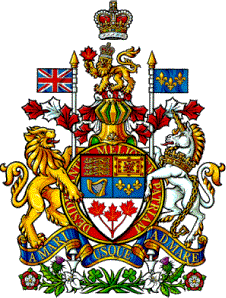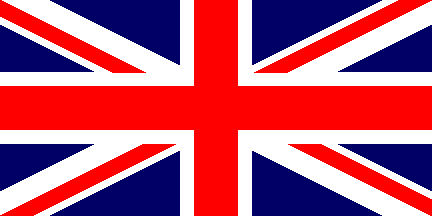
Official Lyrics of O Canada!
|
English Version O Canada! Our home
and native land! O Canada! Where
pines and maples grow, Ruler supreme,
who hearest humble prayer, |
Version française Ô Canada!
Terre de nos aïeux. Amour sacré
du trône et de l'autel
|
"O Canada" was proclaimed Canada's national anthem on July 1, 1980, 100 years after it was first sung on June 24, 1880. The music was composed by Calixa Lavallée, a well-known composer; French lyrics to accompany the music were written by Sir Adolphe-Basile Routhier. The song gained steadily in popularity. Many English versions have appeared over the years. The version on which the official English lyrics are based was written in 1908 by Mr. Justice Robert Stanley Weir. The official English version includes changes recommended in 1968 by a Special Joint Committee of the Senate and House of Commons. The French lyrics remain unaltered.
Click HERE for more information
The Royal Anthem: God Save the Queen
|
God
save our gracious Queen, |
Thy
choicest gifts in store Our
loved Dominion bless |
As a member of the British Commonwealth, Canada also uses God Save the Queen (the British National Anthem) in addition to O Canada. It is used in the presence of the Queen, other members of the Royal Family and the Governor General of Canada.
To visit a site where you can listen to the song, Click HERE
Canadian National Flag:
The official ceremony
inaugurating the new Canadian flag was held on Parliament Hill in Ottawa on
February 15, 1965, with Governor General Georges Vanier, Prime Minister Lester
B. Pearson, the members of the Cabinet and thousands of Canadians in attendance.
The Canadian Red Ensign, bearing the Union Jack and the shield of the royal
arms of Canada, was lowered and then, on the stroke of noon, our new maple leaf
flag was raised. The crowd sang the national anthem O Canada followed by the
royal anthem God Save the Queen.
The following words, spoken on that momentous day by the Honourable Maurice Bourget, Speaker of the Senate, added further symbolic meaning to our flag: "The flag is the symbol of the nation's unity, for it, beyond any doubt, represents all the citizens of Canada without distinction of race, language, belief or opinion."
Canadian Coat-of-Arms:

The present design of the arms of Canada was drawn by Mrs. Cathy Bursey-Sabourin, Fraser Herald at the Canadian Heraldic Authority, office of the Governor General of Canada, and faithfully depicts the arms described in the words of the Royal Proclamation dated November 21, 1921. The present design was approved in 1994 and shows a ribbon behind the shield with the motto of the Order of Canada. This version replaces a former design drawn by Mr. Alan Beddoe.
Canada's coat of arms contains the arms of England, France, Ireland, and Scotland denoting the founding peoples. Beneath the four quarters is a white field with a sprig of three maple leaves, originally green, but changed to red in 1957. The arms were proclaimed by George V on November 21, 1921.

General
The Royal Union flag, commonly known as the "Union Jack", has a long
history of usage in Canada dating back to the British settlement in Nova Scotia
after 1621. Although the Red Ensign was widely used in Canada from the time
of Confederation until the national flag was adopted in 1965, the Union Jack
was the affirmed national symbol from 1904 and was the flag under which Canadian
troops fought during the First World War. The Union Jack maintains its presence
in Canada through its incorporation in the provincial flags of Ontario, Manitoba,
and British Columbia.
When flown or displayed in Canada, the Union Jack serves two purposes. First, it is the national flag of the United Kingdom, and second, it is flown as a symbol of membership in the Commonwealth and allegiance to the Crown as approved by Parliament on December 18, 1964.
The order of precedence of the Union Jack in relation to provincial and territorial flags varies in accordance with the reason it is flown.
When representing the
United Kingdom as a sovereign nation, the Union Jack takes precedence before
the flag of a province or territory;
when representing Canada's membership in the Commonwealth or allegiance to the
Crown, for example during a Royal Visit, the Union Jack is considered as a "symbolic
flag" and as such is displayed after any other flag.
When the Union Jack is flown during a visit to Canada by a person representing the United Kingdom, the normal grouping of one Canadian flag and one Union Jack will be followed. On some occasions, it may be deemed necessary to add a provincial flag to the display. In this case the Union Jack will take precedence before the provincial flag as it represents the United Kingdom.
The Union Jack will, where physical arrangements allow, be flown along with the Canadian flag at federal buildings, airports, military bases, and other appropriate establishments within Canada, from sunrise to sunset, on the following occasions annually:
Physical arrangements means the existence of at least two flag poles. The Canadian flag will always take precedence and will not be replaced by the Union Jack. Where only one pole exists, no steps shall be taken to erect an additional pole.
The Union Jack may be flown with the Canadian flag at the National War Memorial
and at similarly appropriate locations in Canada in connection with ceremonies
marking anniversaries of events in which Canadian forces participated with other
Commonwealth forces
Pledge of Allegiance:
There is no pledge of
allegiance to the Canadian flag any more. Although many Canadians still believe
there is one.
The closest one may come to seeing a pledge of allegiance for all Canadians
may come from this passage from a copy of the page taken from the 1960 Canadian
Bill of Rights.
"I
am a Canadian, free to speak without fear,
free to worship in my own way,
free to stand for what I think right,
free to oppose what I believe wrong,
or free to choose those who shall govern my country.
This heritage of freedom I pledge to uphold for myself and all mankind."
From John
Diefenbaker (From the Canadian Bill of Rights, July 1, 1960.)
FYI
![]() The name
Canada is derived from the Huron-Iroquois word "Kanata", meaning a
"village" or "settlement". On August 13, 1535, Jacques Cartier
is reported to have encountered the word when some Indian youths directed him
to the village of Stadacona, on the site of present-day Quebec City. The word
soon came to mean "the province of Canada".
The name
Canada is derived from the Huron-Iroquois word "Kanata", meaning a
"village" or "settlement". On August 13, 1535, Jacques Cartier
is reported to have encountered the word when some Indian youths directed him
to the village of Stadacona, on the site of present-day Quebec City. The word
soon came to mean "the province of Canada".
![]() Canada's
motto is A Mari Usque ad Mare (From sea to sea).
Canada's
motto is A Mari Usque ad Mare (From sea to sea).
![]() Canada's
emblems are the maple leaf and the beaver.
Canada's
emblems are the maple leaf and the beaver.
![]() Canada's
official languages are English and French.
Canada's
official languages are English and French.
![]() Canada
came into its own in 1791 when the Constitutional Act (or Canada Act) divided
Quebec into the provinces of Upper Canada and Lower Canada. In 1841 they were
joined together to form the Province of Canada. On July 1, 1867, the British
North America Act came into effect and, the Province of Canada (divided into
Ontario and Quebec) joined with Nova Scotia and New Brunswick to form "One
Dominion under the name of Canada". In 1870 the Hudson's Bay Company surrendered
to the crown large territories in its possession from which the remaining provinces
and territories were created. Manitoba entered Confederation in 1870, British
Columbia in 1871, Prince Edward Island in 1873, Saskatchewan and Alberta in
1905, and Labrador and Newfoundland in 1949. Yukon Territory was created in
1898, Northwest Territories in 1905, and Nunavut "Our Land", Canada's
newest Territory, on April 1, 1999.
Canada
came into its own in 1791 when the Constitutional Act (or Canada Act) divided
Quebec into the provinces of Upper Canada and Lower Canada. In 1841 they were
joined together to form the Province of Canada. On July 1, 1867, the British
North America Act came into effect and, the Province of Canada (divided into
Ontario and Quebec) joined with Nova Scotia and New Brunswick to form "One
Dominion under the name of Canada". In 1870 the Hudson's Bay Company surrendered
to the crown large territories in its possession from which the remaining provinces
and territories were created. Manitoba entered Confederation in 1870, British
Columbia in 1871, Prince Edward Island in 1873, Saskatchewan and Alberta in
1905, and Labrador and Newfoundland in 1949. Yukon Territory was created in
1898, Northwest Territories in 1905, and Nunavut "Our Land", Canada's
newest Territory, on April 1, 1999.
![]() Canada's
provinces and territories...10 provinces, listed from East to West are:
Canada's
provinces and territories...10 provinces, listed from East to West are:
Newfoundland
Prince Edward Island
Nova Scotia
New Brunswick
Quebec
Ontario
Manitoba
Saskatchewan
Alberta
British Columbia
The three territories from East to West are:
Nunavut Territory
Northwest Territories
Yukon Territory
![]() According
to the 2001 census, Canada has a total of 9,012,112 square kilometers.
According
to the 2001 census, Canada has a total of 9,012,112 square kilometers.
![]() Canada
is the second largest country in the world with a population of 31,592,805
(July 2001 est.) .
Canada
is the second largest country in the world with a population of 31,592,805
(July 2001 est.) .
![]() More
Facts on Canada from the CIA
More
Facts on Canada from the CIA